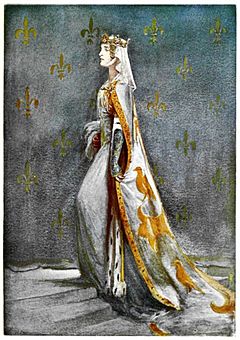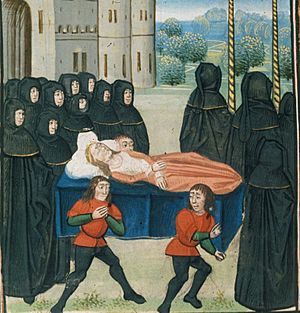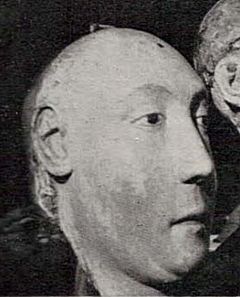Anne of Bohemia facts for kids
Quick facts for kids Anne of Bohemia |
|
|---|---|
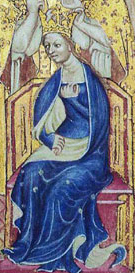 |
|
| Queen consort of England | |
| Tenure | 20 January 1382 – 7 June 1394 |
| Coronation | 22 January 1382 |
| Born | 11 May 1366 Prague, Kingdom of Bohemia |
| Died | 7 June 1394 (aged 28) Sheen Palace, England |
| Burial | 3 August 1394 Westminster Abbey, London |
| Spouse | |
| House | Luxembourg |
| Father | Charles IV, Holy Roman Emperor |
| Mother | Elizabeth of Pomerania |
Anne of Bohemia (born May 11, 1366 – died June 7, 1394) was the first wife of King Richard II. This made her the Queen of England. She was also known as Anne of Luxembourg.
Anne was part of the House of Luxembourg, a powerful royal family. Her father was Charles IV, Holy Roman Emperor, who was also the King of Bohemia. Her mother was Elizabeth of Pomerania. Anne died at the young age of 28. It is believed she died from the plague.
Early Life
Anne had four brothers, including Sigismund, who later became a Holy Roman Emperor. She also had one younger sister. From her father's earlier marriages, she had five half-siblings.
Anne grew up mostly at Prague Castle in Bohemia. Her brother, King Wenceslaus IV of Bohemia, often looked after her. When she traveled to England to become queen, her uncle, Wenceslaus I, Duke of Luxembourg, protected her.
Queen of England
King Richard II married Anne of Bohemia in 1382. This marriage was partly due to a big problem in the church called the Western Schism. During this time, there were two rival popes. Pope Urban VI supported the marriage. He hoped it would create an alliance to strengthen him against the French and their chosen pope.
Anne's father was one of the most powerful rulers in Europe. He controlled a large part of the continent. However, many English nobles and members of Parliament did not want Richard to marry Anne. They thought he should marry Caterina Visconti from Milan, who would have brought a lot of money as a dowry. A dowry is money or property a bride brings to her husband.
Instead, Anne was chosen, even though she brought no dowry. In fact, Richard paid 20,000 florins (a large sum of money back then) to Anne's brother, King Wenceslaus IV of Bohemia. This payment was part of the marriage agreement. The marriage did allow English merchants to trade freely in Bohemia and the Holy Roman Empire.
Negotiations for the marriage took a long time. The marriage treaty was finally signed in May 1381.
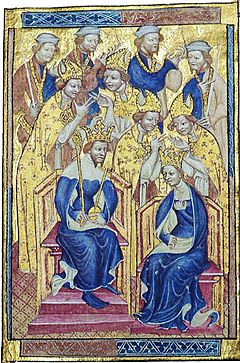
Anne arrived in England in December 1381. Her journey was delayed by storms. Some writers at the time criticized her, perhaps because of the money paid for the marriage. One writer called her "a tiny scrap of humanity." Another said her ships were smashed after she got off them.
Despite this, Anne and King Richard II were married at Westminster Abbey on January 20, 1382. They were both only 15 years old. Londoners were not always welcoming at first. After the wedding, tournaments were held for several days to celebrate. The royal couple then traveled around the country.
Even though their marriage was arranged, Anne and Richard grew to love each other deeply. The king was very devoted to his new wife.
Anne's father's court in Prague was famous for its beautiful art style called International Gothic. When Anne came to England, she likely brought new artistic ideas with her. The Crown of Princess Blanche, which is now in Munich, might have been made for Anne.
Anne and Richard were married for 12 years. However, they did not have any children. Anne's death from the plague in 1394 was a terrible loss for Richard. He was so sad that he tore down Sheen Manor, the place where she died. Historians believe that Anne helped Richard make good decisions. After she died, his choices became less wise, and he eventually lost his throne.
Richard later married his second wife, Isabella of Valois, in 1396. She was only six years old.
A Popular Queen
Even though some people didn't like Anne at first, she became very popular over time. She was known for being a kind person. She often tried to help ordinary people by asking the king for mercy. For example, she helped get pardons for people who took part in the Peasants' Revolt of 1381. She also helped many other people who had done wrong. In 1389, she asked for a pardon for a man accused of murder.
Anne also spoke up for important people in front of the king. In 1384, she saved the life of John Northampton, a former mayor of London. Her humble pleas convinced Richard II to only imprison him for life instead of executing him.
Her most famous act of kindness was helping the citizens of London in 1392. This was when Richard and London had a formal reconciliation after a disagreement. Anne's role in this event was even written about in a poem.
Anne also tried to help Simon de Burley, who had been Richard II's teacher. This happened during a difficult time in Parliament in 1388. Despite her pleas, Burley was executed.
Anne did not have children, which was an important duty for queens back then. But people still thought she helped the kingdom. One writer said, "this queen, although she did not bear children, was still held to have contributed to the glory and wealth of the realm." Her nickname, "Good Queen Anne," shows that people liked her very much, even without children.
Legacy
Anne is buried next to her husband in Westminster Abbey. In 1395, Richard ordered a special monument for both of them. This was the first time an English king ordered a double tomb for a royal burial. The tomb was made of marble and had two life-size statues of Anne and Richard. Their statues were made of gilded copper and were crowned. Their right hands were joined together.
Anne of Bohemia is also known for making the sidesaddle more popular for ladies in the Middle Ages. This way of riding allowed women to sit sideways on a horse. She also influenced the design of carriages in England. She arrived in a carriage from Hungary, and the word "coach" (for a carriage) is thought to come from the Hungarian town of Kocs. Anne also made the tall, horned Bohemian-style headdress a popular fashion for Englishwomen in the late 14th century.
Arms
See also
 In Spanish: Ana de Luxemburgo para niños
In Spanish: Ana de Luxemburgo para niños



